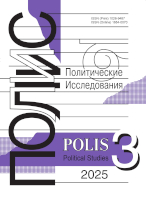The Afghan migration crisis and U.S. policy
Tsapenko I.P.,
Doctor of Economics, Primakov National Research Institute of World Economy and International Relations, Moscow, Russia, tsapenko@imemo.ru
elibrary_id: 72045 | ORCID: 0000-0001-6065-790X | RESEARCHER_ID: B-1993-2017
Article received: 2022.06.08. Accepted: 2022.11.03

DOI: 10.17976/jpps/2023.01.05
EDN: DYEZUX
Tsapenko I.P. The Afghan migration crisis and U.S. policy. – Polis. Political Studies. 2023. No. 1. https://doi.org/10.17976/jpps/2023.01.05. EDN: DYEZUX
The reported study was funded by RFBR, project number 20-014-00001 А “Global and Regional Effects of US Economic Policy in the second – the beginning of the third decade of the XXI century: New Challenges and Chances for Russia”.
The social dynamics of the modern turbulent world reveals an increasing correlation between migration and crises. This nexus is characterized by the emergence of a large number of migration crises in different parts of the world. Despite the widespread use of the term “migration crisis”, its content has not yet been clearly defined and requires some clarifications. The author proposes an interpretation of the migration crisis as a multidimensional social process, which is caused by the mobility and immobility of the population in abnormal conditions and generates multiple, serious challenges for migrants, people trapped in social and natural disasters, and wider social strata, as well as migration management systems in countries of origin, transit and destination. The Afghan migration crisis turned out to be one of the largest, longest and most acute in the world. As the analysis of the internal and external displacement movements of the population, carried out in line with the crisis approach to mobility, shows, these characteristics of the Afghan crisis are explained by the structural format, the long duration of action, the overlap and mutual reinforcement of a number of factors that generate and feed the inexhaustible forced flows of Afghans, which are often cyclical. The Afghan example testifies to the great importance and, at the same time, the duality of the role of external forces in the course of a migration crisis. Not only the military operations of American troops in Afghanistan, but also the withdrawal of the latter, as well as the subsequent measures of the J. Biden administration, contributed to the aggravation and prolongation of the situation there. Although the presence of the US army was initially accompanied by a surge in the repatriation of refugees and the United States sheltered a small part of the Afghans fleeing war and persecution on its territory, this only slightly contributed to mitigating the consequences of the crisis, without reducing the general destabilizing effect of American policy on the migration situation in Afghanistan and around it.
References
Afghanistan: opinion survey and in-depth research. (2009). Geneva: Ipsos/ICRC. 82 p. https://www.icrc.org/en/doc/assets/files/2011/afghanistan-opinion-survey-2009.pdf
Batalova, J. (2021). Afghan immigrants in the United States. Migration Information Source, 09.09. https://www.migrationpolicy.org/article/afghan-immigrants-united-states
Black, R., & Collyer, M. (2014). Populations ‘trapped’ at times of crisis. Forced Migration Review, 45, 52-56. https://www.fmreview.org/sites/fmr/files/FMRdownloads/en/crisis/black-collyer.pdf
Cantat, C., Thiollet, H., & Pecoud, A. (2019). Migration as crisis. A framework paper. MAGYC. 42 р. https://cupdf.com/document/lead-author-cline-cantat-migration-crisis-and-security-since-the-nineties.html
Cordesman, A.H. (2021). The Taliban takeover: plan now for the next crisis in Afghanistan. CSIS. Center for Strategic and International Studies. Working Draft. 4 p.
Chishti, M., & Gelatt, J. (2021). U.S. Government rush to evacuate Afghan allies and allocate sufficient special visas comes at eleventh hour. Migration Information Source, 27.07. https://www.migrationpolicy.org/article/us-government-rush-evacuate-afghan-allies-allocate-special-visas
Global Peace Index 2020: measuring peace in a complex world. (2020). Sydney: IEP. 103 p. https://www.visionofhumanity.org/wp-content/uploads/2020/10/GPI_2020_web.pdf (accessed 10.11.2022).
Hamlin, R. (2022). ‘Migrants’? ‘Refugees’? Terminology is contested, powerful, and evolving. Migration Information Source, 24.03. https://www.migrationpolicy.org/article/terminology-migrants-refugees-illegal-undocumented-evolving (accessed 10.11.2022).
Human development report: 2020. (2020). New York: UNDP (UN Development Programme). 396 p.
Huysmans, J. (2000). The European Union and the securitization of migration. Journal of Common Market Studies, 38(5), 751-777. https://doi.org/10.1111/1468-5965.00263
King, R., & Mai, N. (2011). Out of Albania. From crisis migration to social inclusion in Italy. New York; Oxford: Berghahn Books. 294 p.
Lindley, A. (2014). Exploring crisis and migration: concepts and issues. In A. Lindley (Ed.), Crisis and Migration. Critical Perspectives (pp. 4-26). Abington; London: Routledge. https://doi.org/10.4324/9780203078846
Lopez-Lucia, E. (2015). Migration and conflict in Afghanistan. GSDRC, Helpdesk Research Report 1243. Birmingham: University of Birmingham. 7 р. https://gsdrc.org/wp-content/uploads/2016/02/HDQ12432.pdf
Lubkemann, S.C. (2008). Involuntary immobility: on a theoretical invisibility in forced migration studies. Journal of Refugee Studies, 21(4), 454-475. https://doi.org/10.1093/jrs/fen043
Majidi, N. (2017). From forced migration to forced returns in Afghanistan: policy and program implications. Washington, DC: MPI. 27 p. https://www.migrationpolicy.org/sites/default/files/publications/TCM2017-Afghanistan-FINAL.pdf
Martin, S., Weerasinghe, S., & Taylor, A. (2013). Crisis migration. The Brown Journal of World Affairs, 20(1), 123-137. https://bjwa.brown.edu/20-1/crisis-migration
McAdam, J. (2014). Conceptualizing “Crisis Migration”. In S.F. Martin, S. Weerasinghe, & A. Taylor (Ed.), Humanitarian Crises and Migration: Causes, Consequences and Responses (pp. 28-49). Abington: Routledge. https://doi.org/10.4324/9780203797860
Menjivar, C., Ruiz, M., & Ness, I. (Ed.). (2019). The Oxford handbook of migration crises. Oxford: Oxford University Press. 952 p. https://doi.org/10.1093/oxfordhb/9780190856908.001.0001
New threats to human security in the Anthropocene. Demanding greater solidarity. (2022). Special Report 2022. New York: UNDP. 175 p. https://hs.hdr.undp.org/pdf/srhs2022.pdf (accessed 10.11.2022).
Sayed, N., Sadat, F., & Khan, H. (2021). Will the Taliban’s takeover lead to a new refugee crisis from Afghanistan? Migration Information Source, 02.09. https://www.migrationpolicy.org/article/taliban-takeover-new-refugee-crisis-afghanistan
Sironi, A., Bauloz, C., & Emmanuel, M. (Ed.). (2019). IOM glossary on migration. Geneva: International Organization for Migration. 248 p. https://publications.iom.int/system/files/pdf/iml_34_glossary.pdf
Tsapenko, I.P. (2021). Forced mobility and immobility in a turbulent world. Herald of the Russian Academy of Sciences, 91(5), 525-534. https://doi.org/10.1134/S1019331621050099. EDN: XFFFKY
Weiner, M. (1995). The global migration crisis: challenge to states and to human rights. New York: Harpers Collins College. 253 p.
Willner-Reid, M. (2017). Afghanistan: displacement challenges in a country on the move. Migration Information Source, 16.11. https://www.migrationpolicy.org/article/afghanistan-displacement-challenges-country-move (accessed 11.11.2022).
Zolberg, A.R., Suhrke, A., & Aguayo, S. (1989). Escape from violence. Conflict and the refugee crisis in the developing world. Oxford: Oxford University Press. 400 p.
Amini, A. (2021). Failure of the US and NATO mission in Afghanistan and the forecast of the situation in Afghanistan under the “New Taliban regime”. PolitBook, 3, 99-110. (In Russ.) https://www.elibrary.ru/download/elibrary_47484628_35107552.pdf
Kulagin, A.I. (2016). On specifics of the geopolitical position of Afghanistan in the modern world. Theories and Problems of Political Studies, 3, 177-188. (In Russ.) https://www.elibrary.ru/download/elibrary_26742077_82142770.pdf
Olimova, S., & Olimov, M. (2005). Trudovaya migratsiya v Afganistane [Labor migration in Afghanistan]. Document No. 182. Moscow: Institute of Ethnology and Anthropology RAS. 36 p. (In Russ).
Ryazantsev, S.V. (2021). Migration crisis: concept and criteria. DEMIS. Demographic Research, 1(1), 7-16. (In Russ). https://doi.org/10.19181/demis.2021.1.1.1
See also:
Potapov V.Ya.,
National and international security: political and military aspects. – Polis. Political Studies. 2015. No1
Bardin A.L.,
The Problem of Migration in German Academic Discourse. – Polis. Political Studies. 2016. No6
Tsapenko I.P.,
Challenges of migration for foreign policy and its instrumentalization. – Polis. Political Studies. 2025. No1
Tzymbursky V.L.,
Ultra-Long War Cycles and World Politics. – Polis. Political Studies. 1996. No3
Malakhov V.S., Kascian K.,
The EU’s Migration Dilemma: Legal and Political Dimensions. – Polis. Political Studies. 2020. No4





.jpg)






 print
print
.jpg)
.jpg)